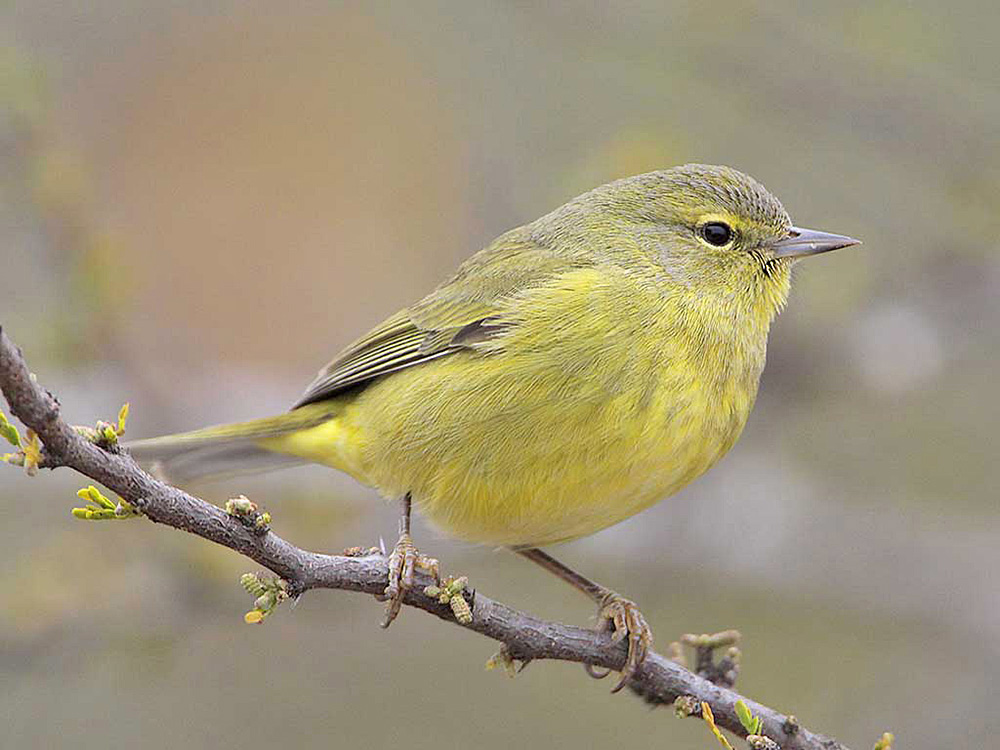The Orange-crowned Warbler is small in comparison to other warblers. This warbler species have prominent, sharply pointed, thin bills, square tails, and short wings.
The Orange-crowned Warbler is not the most eye-catching species of warbler; however, they’re a great one to learn about.
On this page
Identification
Adult Orange-crowned Warblers are overall plain olive or yellowish. Birds on the Pacific coast are grayer on the head than birds who live farther east. Additionally, they have partial pale eyerings, a yellow or white line over the eye, and a black-looking stripe through the eye.
The Orange-crowned Warbler has an orange patch on its crown; this is how it got its name. However, this orange section on the head is almost never seen. It only becomes visible when the bird is agitated or excited and it raises its head feathers.
These birds are 4.3 to 5.5 inches long, weigh 0.3 to 0.4 ounces, and have a wingspan of 7.5 inches. That makes them a little bit smaller than Yellow-rumped Warblers and a little bit bigger than Ruby-crowned Kinglets.
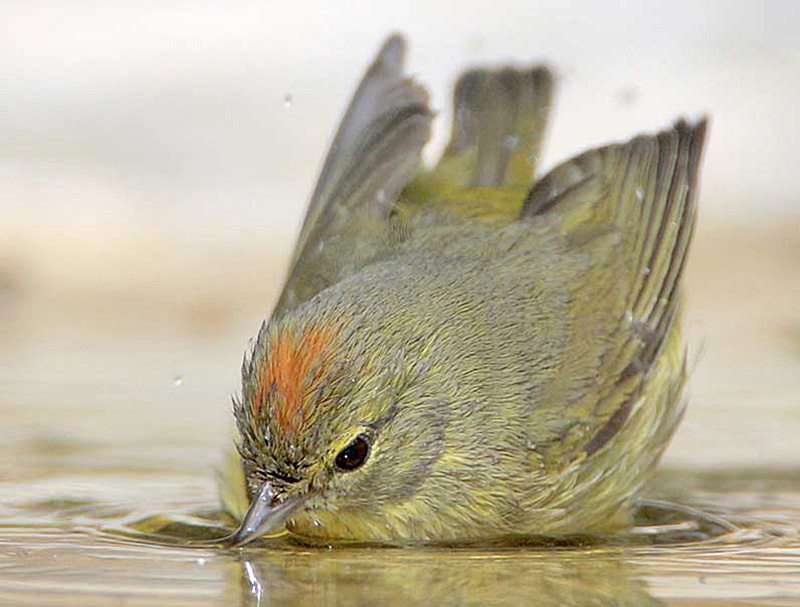
Photograph © Greg Lavaty.
Female Orange-crowned Warblers look identical to breeding male Orange-crowned Warblers.
Juvenile Orange-crowned Warblers are usually grayer than adults. Note their faint eyeline and broken eyering. The incubation period only lasts around 11 to 13 days. When the chicks are born, they receive constant care from both mom and dad. They’re ready to leave the nest when they’re 10 to 13 days old. The parents will continue to feed them for a few days after they leave the nest.
Orange-crowned Warblers living near the Pacific coast are yellowish, bright birds that are often mistaken for Yellow Warblers. The line over the eye and their underparts are consistently yellow.
Their olive streaks are blurry and contrast more than other warbler species. In the interior portions of the west, Orange-crowned Warblers commonly have gray heads, but some may have yellow-green crowns. Whatever the case, their heads contrast significantly with their brighter olive backs.
Food
Orange-crowned Warblers primarily consume invertebrates like beetles, ants, spiders, caterpillars, and flies. Look for these birds on the ground all the way up to the treetops. They clamber, flit, and poke through vegetation.
Orange-crowned Warblers supplement their diet with fruits, plant galls, and seeds. They’re commonly seen at the sap wells that woodpeckers like sapsuckers have drilled.
Additionally, these birds have been observed piercing the base of flowers to get to their nectar.
If you would like to attract Orange-crowned Warblers to your yard, you’ll be happy to know they will visit backyard bird feeders! Put out sugar water, peanut butter, or suet to attract them.
Nesting and Eggs
Female Orange-crowned Warblers are the ones who choose the nesting site. She’ll flutter through low vegetation and choose a nesting area on or near the ground.
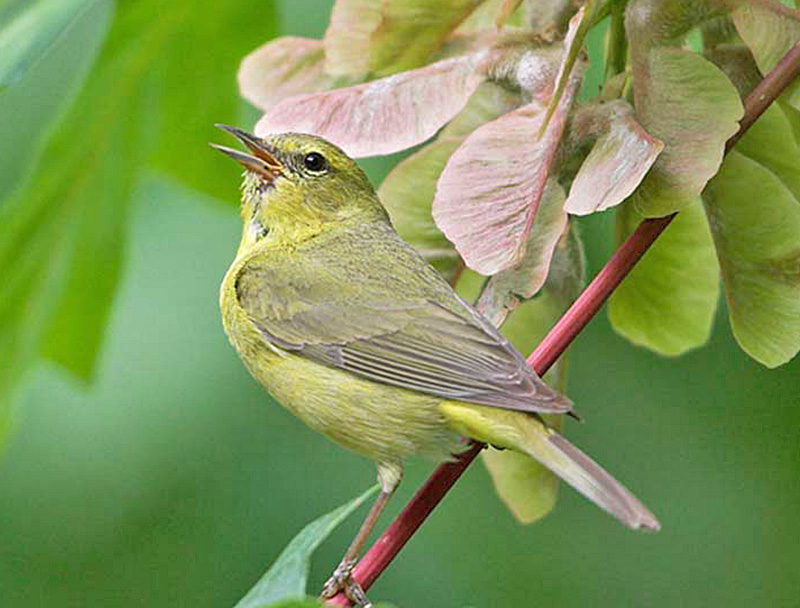
Photograph © Glenn Bartley.
Nest sites include trail cuts, steep roads, shady hillsides, the bases of snowmelt drainages, and canyons or gullies. The nesting site is usually sheltered by vegetation. Nests may be built in rock cracks, depressions in the soil, on moss, or on the ground nestled in fern fronds or right below woody plants.
The female Orange-crowned Warbler creates the nest. It can take up to 4 days for the open cup of the nest to form. This open cup is usually 2.5 inches tall and 4 inches wide.
First, she’ll lay a foundation of stems, dead leaves, and other rough plant material. Next, she’ll weave an outer layer of rough grass, sheep wool, leaves, fine twigs, wood, bark, and moss. Lastly, the nest cup is lined with animal hair and finer grasses.
Orange-crowned Warblers have a clutch size of 3 to 6 eggs. Eggs are cream-colored to white and are finely spotted with chestnut or reddish-brown.
Current Situation
Orange-crowned Warblers are a common bird in certain portions of their breeding range. However, their populations have declined by 28% between the late 1960s and 2019. The most notable decline was in the U.S., where populations fell by 54% during that time.
Their estimated breeding population is 82 million; in the IUCN Red List, they are marked as species of low concern.
Overall, these warblers most likely benefit from logging practices because they create dense shrub growth and open up forest canopies. On the other hand, some practices damage shrub layers and can reduce the aptness of their habitat. Examples of some practices that damage habitat are cattle grazing and logging practices.
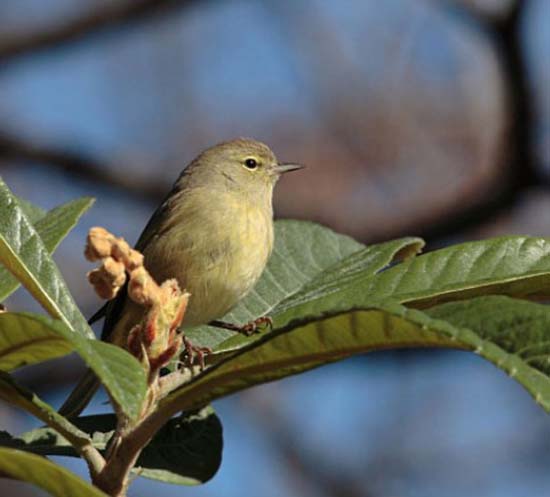
Look for these birds in low-growing vegetation and shrubs in chaparral, patches of forest, and riparian settings. This abundant species breeds in various habitat types, like fir-aspen woodlands in Arizona and willows and alders in coastal Alaska.
The Orange-crowned Warbler breeds in logged or open forests in the northern Rockies. Overall, they breed in more forest types than nearly any other warbler species. Wintering Orange-crowned Warblers seek habitats that have structures similar to their breeding grounds.
This includes second-growth and brushy woodlands in the Caribbean, pine-oak forests in Mexico, and mixed chaparral and oak woodland habitat in southern California.
Facts
- Orange-crowned Warblers usually nest on the ground. It’s believed that they do this to avoid nest-robbing birds. However, there is one exception. The “dusky” subspecies or sordida, breeds on California’s Channel Islands, nest in tall trees and shrubs that are hard for mammals and snakes to access. It’s theorized that they build their nests in these places because there are fewer avian predators to worry about.
- The oldest recorded Orange-crowned Warbler lived to be at least 8 years and 8 months old. It was photographed in California in 2018 in the wild.
- Orange-crowned Warblers stay later on the breeding grounds, begin their spring migration earlier, and winter more north than a lot of other warblers. Most bird migrations are triggered by day length; however, food seems to drive this warbler species’ migratory calendar.
Similar Species
The Orange-crowned Warbler has features that are similar to other bird species. Here are some similar species:
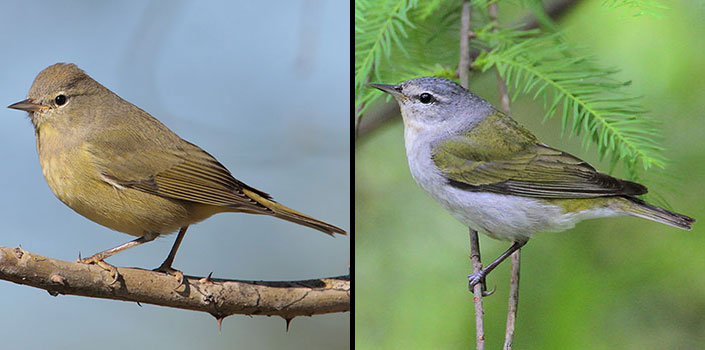
Orange-crowned Warbler (left) and Tennessee Warbler (right)
Orange-crowned Warblers have weaker eyelines, less white under tail coverts, and blurry stripes on their belly compared to Tenessee Warblers.
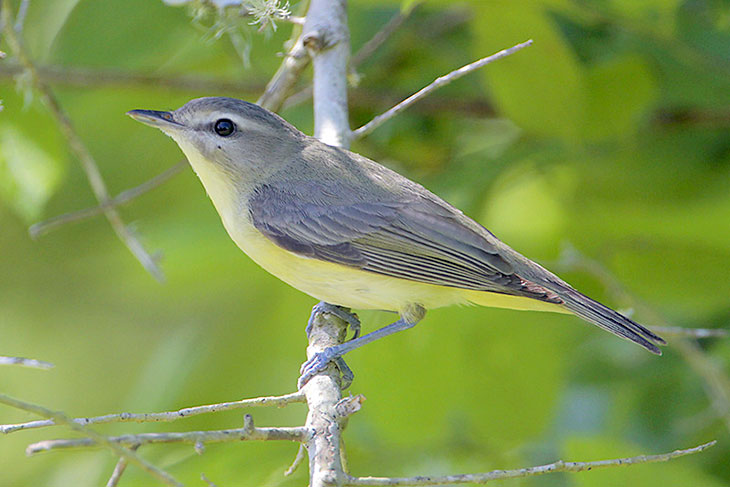
Philadelphia Vireo
Orange-crowned Warblers are smaller, have bolder eyebrows, and thinner bills than Philadelphia Warblers.
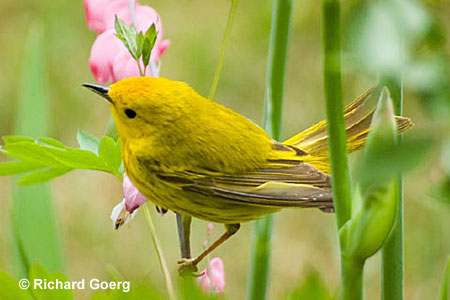
yellow warbler
Orange-crowned Warblers are not as yellow as adult female Yellow Warblers.
Immature Yellow Warblers are less olive and have cleaner bellies and faces than Orange-crowned Warblers.
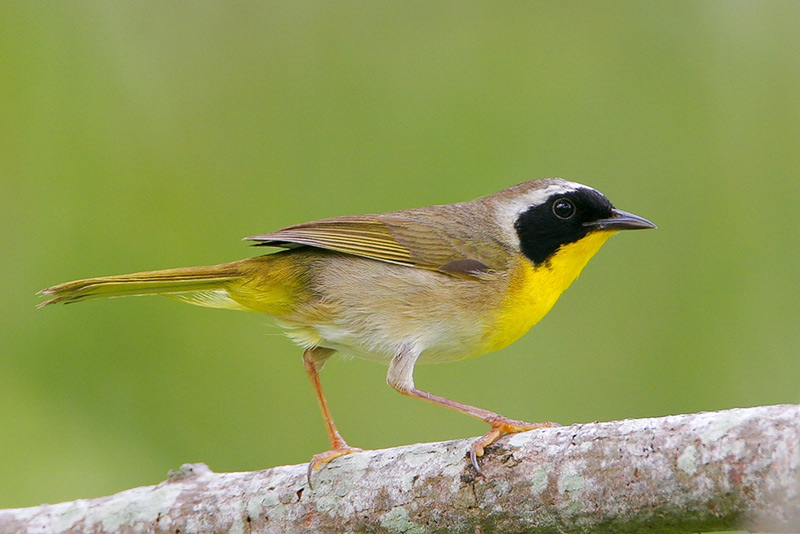
Common Yellowthroat. Photograph © Greg Lavaty.
Female Orange-crowned Warble
rs are not as brown as female Common Yellowthroats.
Orange-crowned Warblers are completely yellow below, while Common Yellowthroats have yellow concentrated on their under tail coverts and throat.
Additionally, Orange-crowned Warlbers have smaller bills.
Frequently Asked Questions
Are Orange-crowned Warblers rare?
No, Orange-crowned Warblers are not rare. Their estimated breeding population is 82 million and they can be found across most of North America, making them a widespread bird.
How big is an Orange-crowned Warbler?
Orange-crowned Warblers are 4.3 to 5.5 inches (11 to 14 centimeters) long, weigh 0.3 to 0.4 ounces (7 to 11 grams), and have a wingspan of 7.5 inches (19 centimeters).
Does the Orange-crowned Warbler have an orange crown?
Yes, the Orange-crowned Warbler has an orange patch on its crown; this is how it got its name. However, this orange section on the head is almost never seen. It only becomes visible when the bird is agitated or excited and raises the feathers on its head.

